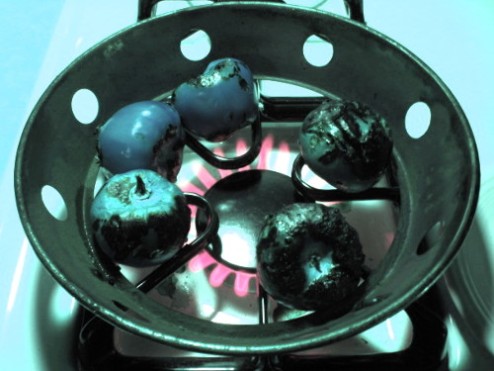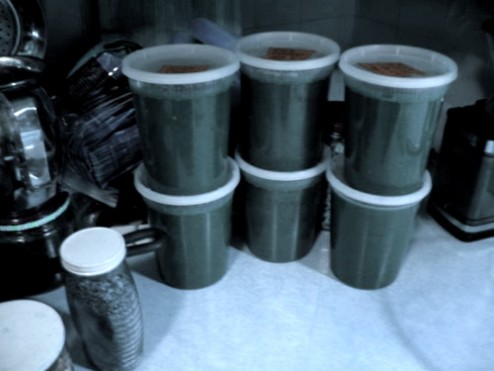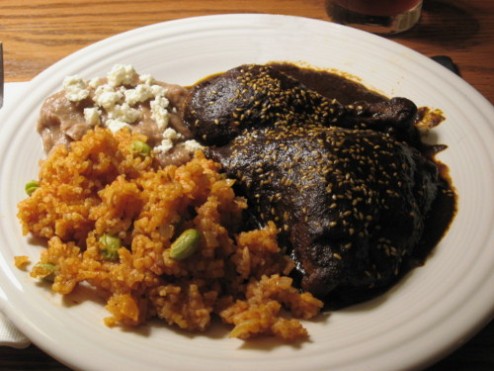Mole Poblano
A few months ago I held a quiz, and the grand winner of that rather tricky quiz was a very dear blogging-friend of mine who somehow managed to choose her own prize! Luckily, the poor thing seldom has visitors to her blog and, thus, has no need to run and hide in shame. 😀 Nevertheless, fair is fair and the agreed-upon prize (did I say that?) was that I would cook and post any dish of her choosing. Sounds easy eh? Not! She chose a dish that I have made but once before, and in that a most time-consuming, complicated, and basically the greatest pain-in-the-ass recipe I’ve ever cooked in my life… mole poblano… There might be people out there who could attest, in queso blanco-like modesty, that, in the end, it is worth all of the effort.
The word mole is used in Mexico to denote a complicated sauce, and is decended from the Aztec word molli which means a sauce or mixture containing chiles. Mole poblano is the most well-known of them, and is the basis of the holiday dish, mole poblano de guajolote (Pueblan mole of turkey), but it is just as often, if not moreso, used to cook chicken (mole poblano de pollo), and sometimes pork or other meats. There is a fanciful legend in Mexico about the dish’s origin, and it goes something like this:
“…in the 16th century the nuns of the convent of Santa Rosa in the city of Puebla heard that the archbishop was coming to visit them. They went into a panic because the convent had nothing suitable to offer such a distinguished visitor, but after a while they rallied, prayed and- with heavenly guidance- began to grind and chop everything edible that they had in the kitchen. Into the mix went (among other things) many kinds of chile, almonds, tomatoes, onions, garlic, bread, tortillas, bananas, sesame seeds, sugar, raisins, lard, toasted avocado leaves and innumerable herbs and spices. All were finely ground and cooked for hours. The final touch was a small quantity of chocolate, which gave the mole its subtle flavour. While the sauce was simmering in a great pot the nuns killed their one and only turkey (which was intended for the local bishop), cut it up and cooked the meat. When the archbishop arrived, they served the turkey with the miraculous mole poured over it. The noble guest was, of course, delighted. The angels who guided the hands of the nuns had created the most delicious dish that he had ever tasted.” *
In truth, mole poblano is a very Aztec dish, with a few Spanish ingredients whirled into the mix. While quite likely that the nuns in the convents of post-conquest Mexico did indeed improve upon the dish, it almost certainly was in existence long before that time (there are, besides the Pueblan-style, many other types of mole– guaca-mole, for example, being quite familiar to many- all considered classics of Mexico’s various cuisines and definitely worth furthur investigation). I have tasted mole poblano many times, in various Mexican restaurants, as it has long been a favorite: I fell in love with its intoxicating, nearly-indescribable, subdued chocolate-laden bouquet from the first bite! As other afficionados will attest, nothing else in the world is quite like it…
Here is my quite-recent rendition of mole poblano, which I have based upon several recipes that I had gathered, the most-admired from The Taste of Mexico by Patricia Quintana. I ended up with 27 ingredients for the sauce alone (33 after I cooked chicken in it), but the resulting tasks are quite easily accomplished in parts. I’d recommend taking three days. I divided the ingredients into categories with similar treatments, with my own steps explained afterward. You may choose a different order entirely, of course. This recipe makes enough sauce for 20 lbs. of turkey or chicken. Obviously this is enough for a banquet, but since it is almost as easy(?!) to make a large amount (and freeze what is unused for later meals) as it is a small one, I chose to go ahead with it, but you can divide it for smaller portions if you wish. I chose to thin the sauce as it simmers with just water, leaving the sauce neutral to re-thin and simmer again later with various meat stocks, or to keep as is for vegetarian meals. Lard is the traditional fat used for frying the various ingredients (and it does lend a unique flavour to foods cooked with it), but I chose to use peanut oil, again for neutrality and also to reduce the saturated fat content. Use as much as you feel necessary, keeping in mind that 2-3 cups is traditional for this quantity. I managed to use around 1 cup.
Mole Poblano
Chiles:
30 dried mulato chiles
16 dried ancho chiles
6 dried pasilla or pasilla negra chiles
2 dried chipotle chiles
1)Remove the seeds and membranes of the mulato, ancho and pasilla chiles; tear into small pieces. Take these pieces and roast lightly- in batches of three large handfuls or so- until they blister and turn a shade darker- in a pan set over med-low heat, pressing with a spatula, turning, pressing…about 10 turns. I will warn you that the chile-fumes can be quite irritating to the mucous-membrane; open windows if possible.
2)Transfer to a large bowl along with the chipotle chiles and pour boiling water over them to cover, plus an inch or two; set a plate or bowl atop the surface to keep the chiles immersed; soak 30 minutes.
3)Mexican chiles sometimes tend to have traces of dirt still clinging to them (especially ancho chiles), so when removing these pieces from their soaking-liquid, I grab a few at a time and swish them a bit in the water to reduce this to a minimum; transfer to the container of a food processor and puree until very smooth, decanting some of the soaking-water off the top (the dirt settles at the bottom) to add to the container to facilitate easy movement of the mixture. Pass this puree through a metal sieve using a wooden spoon (or use a food-mill/Foley) to attain a smooth sauce, free of annoying bits of chile-skin.
Nuts:
3/4 C raw almonds
1/2 C raw peanuts
1/2 C raw pepitas (pumpkin seed kernels)
1)Take 3 T of oil and fry the nuts separately, in the order given, over med-low heat until fragrant and golden; drain together on paper or in a metal sieve.
2)When cool, grind very well into as smooth a paste as possible. (I used a mortar-and-pestle for the initial grind, then pureed it furthur with later ingredients)
Dried fruit:
1 C pitted prunes
3/4 C raisins/sultanas
1)Using about 2 T of oil, fry the prunes over med-low heat for a few minutes to carmelize; remove and drain.
2)Fry the raisins in the same oil until they swell like little balloons; remove to drain with the prunes; pour boiling/hot water over them to cover and allow to soak for, well…awhile…
Fresh fruits:
1 1/2 ripe plantains
3 ripe tomatoes
10 tomatillos, husks removed
1)Peel and slice the plantain into 1/4″ slices. Fry in a tablespoon or two of oil over med-high heat until lightly browned; remove and set aside.
2)If you have a gas range, line a burner with foil to catch drips and with it set on high, fire-roast the tomatoes and tomatillos directly on the grate, using a pair of tongs to turn occasionally and char to black as much of the skin as possible on each (I used a wok-ring to contain mine). Traditionally, this is done over an open fire, so if you have one, then by all means…this can also be done in a very hot oven by placing the fruits on a parchment-paper-lined baking sheet to roast until the skin is charred. In any case, immediately remove to a covered container- the steam helps to soften the skin. When cool, rub off as much of the charred skin as possible under gently-running water; remove the stems and cores of the tomatillos; add to the bowl containing the fried plantains.
Breads:
1 stale croissant or 2 slices of bread or equivalent (a roti or parantha would be fine), broken into pieces
2 corn tortillas, broken into pieces
1)Fry these separately in the oil left over from the previous fryings until crispy-toasted. Remove to the bowl of fruit.
Spices:
3/4 C white sesame seeds
5″ of true cinnamon, broken into pieces
1 t coriander seeds
1 t anise seeds
1/2 t whole cloves
1/2 t black peppercorns
dried avocado leaves (I could find no reference for how much to use and therefore didn’t include)
1)Wipe the pan of excess oil and roast the sesame seeds, stirring constantly, over a med-low flame until a deeper golden hue is attained. Remove to a bowl to cool.
2)Roast the remaining spices together over a med-low flame, again stirring constantly, until the coriander seeds turn just a shade darker and the mixture is quite fragrant. Remove to a separate bowl to cool.
3)Grind the sesame seeds to a fine paste; grind the other spices to a fine powder.
Alliums:
2 heads(entire bulbs) of garlic
4 onions
1)Separate the cloves of garlic but leave the peels intact. Set them in one layer in the pan over med heat and roast until black and charred in spots, turning every few minutes. Remove and cool, then peel carefully.
2)Cut the onions in half, and then into 1/8″ slices; fry in 4-5 T oil over high flame, stirring constantly, until they begin to brown. Reduce heat and continue browning, never letting the utensil rest, until dark brown (not black) and crispy. Remove to cool.
The end is near with that final touch:
1)Place the chile-puree in a large stock-kettle.
2)Puree the nut-paste with the dried fruits and their soaking-liquid until smooth, adding more water if necessary; add to the kettle.
3)Puree the fresh fruits and the breads, adding water if necessary, until smooth; add to the kettle.
4)Add the ground spices to the kettle.
5)Puree the garlic and onions with a bit of water until smooth; add to the kettle.
6)Mix together well, adding some water if too thick to stir easily; bring gently to a boil over med-low heat, stirring occasionally, and then add:
3/4 C piloncillo, grated (Mexican raw sugar), or other sugar
4 oz. unsweetened chocolate, grated
salt to taste
Continue to boil gently, stirring occasionally, and season sparingly with:
1/4- 1/2 t Mexican oregano (not the same as European/Greek oregano)
Rub the dried herb between your fingers to crush before adding; it has a flavour not unlike ajwain, but with a strange, round, vanilla-like undertone which complements the chocolate note well. Be careful not to overdo it though…keep it subtle.
At this point, after perhaps 20-30 minutes, I decided to turn off the heat, let it cool and divided it into 8 portions (1 quart each). I froze 6 of them with labels stating the following: enough for 2.5 lbs. of meat, thin with stock, simmer 3-4 hours.
The remaining two portions- enough for 5 lbs. of meat- went thus:
5 lbs. (bone-in) chicken
1/2 onion, roughly chopped
5 cloves of garlic, sliced
1 small carrot
1/4 of a celery stalk
2 bay leaves
3 black peppercorns
salt
1)Place all ingredients in a stock-pot and bring to a boil; lower heat and simmer 30 minutes; allow chicken to cool in the stock, then remove.
2)Strain this stock, combine this with enough mole poblano for 5 lbs.(see note below), bring to boil, and lower heat to maintain a gentle boil for 3-4 hours and reduce until thick, stirring frequently, moreso as it thickens.
3)If you wish, remove the skin from the chicken pieces, and, again if you wish, shallow-fry to brown in hot oil (it is likely traditional to brown leaving the skin intact). Place the chicken pieces in the mole and simmer for 30 minutes, covered.
4)Remove to a serving platter and sprinkle with:
A few tablespoons of sesame seeds, toasted as above
Serve with hot tortillas, arroz rojo(red rice pilaf), frijoles(refried beans), salsa picante(hot sauce), and, as I have often been served, pico de gallo (a fresh relish made of tomatoes, onions, green chiles, cilantro, lime juice and salt..maybe some roasted cumin- I forget).
Note (as if there weren’t enough): The mole is usually thinned with a richer stock (ie: return the bones and scraps to the stock and simmer at least 3 hours longer) when cooking meats; I was tired, but I actually liked the diminished chicken taste to better enjoy the other flavours.
“I’m not really interested in how it’s made; just let me eat it, eh?” -Danny
Anita– I seriously loved working on this recipe- great fun with a dish people seldom attempt at home anymore- even amongst Mexicans. Congratulations! and enjoy…
Special bonus! The halved recipe (for 10 lbs. of turkey or chicken):
15 mulato chiles, 8 ancho chiles, 3 pasilla negra chiles, 1 chipotle chile, 3/8 C almonds (1/4 C + 2 T), 1/4 C peanuts, 1/4 C pepitas, 1/2 C prunes, 3/8 C raisins, 3/4 of a ripe plantain, 1 1/2 ripe tomatos, 5 tomatillos, 1/2 of a croissant (or 1 slice of bread or half of a roti, etc), 3/8 C sesame seeds, 2 1/2″ of cinnamon, 1/2 t coriander seeds, 1/2 t anise seeds, 1/4 t whole cloves, 1/4 t black peppercorns, 1 head of garlic, 2 onions, 3/8 C piloncillo, 2 oz. unsweetened chocolate, salt, a pinch of Mexican oregano, oil or fat, and water as required…note that the quantity of chicken used above is for a quartered amount (5 lbs.)- use half of this quantity of sauce and freeze the other.
This is my entry for Jihva for Ingredients- chocolate, hosted this month by Deepz of Letz Cook. JFI is a monthly tradition, created by Indira of Mahanandi.
*Excerpt taken from Latin American Cooking, Jonathon Norton, co. 1968.
Chocolate shrikhand, almond pooris, and an answer to the baffling battiness…
Some of my food-blogging friends and I have had discussions of yoghurt-cheeses and their appearance in several cuisines, including America’s- where cream cheese/Philadelphia cheese and “neufchatel” (though this does not resemble the true French cheese of the same name) are made in a very similar way… It is delectable when paired with fruit- there is no debate of that- but the “chocoholic” in me is continually searching for new ways to express itself, and I am certain that in no way could I be the first to dream up this concoction…
Chocolate, as a bitter drink, was well-known and used by the Aztecs back to antiquity, as was vanilla. The conquering Spaniards combined this with their passion for cinnamon-flavoured sweets (an assertion of the Moorish influence and Arab trade with India) and milk. It is not difficult to see how Mexican-style chocolate was born, and indeed, all other chocolate confections “born” afterward…
In this recipe, I have combined chocolate with a touch of vanilla, and the familiar combination of cardamom and cinnamon- prevalent in Indian coffee and tea preparations- with the milk-become-yoghurt-become-chatta sweet known as shrikhand in Gujju and Marathi -cinnamon being the tie that binds the hands across the world to create this delectable fusion. Mexican drinking chocolate often contains ground almonds as well, so… an appropriate accompaniment, to my mind, had to be freshly-fried almond pooris; I make a final bow to shrikhand’s origin by gracing the chocolate shrikhand with roasted chiroli-nuts…
Resist if you must!
I extend a big thank you to Madhuli of My Foodcourt for her assistance in helping me name the chocolate shrikhand.
Chocolate Shrikhand with Almond Pooris
Chocolate Shrikhand
(4 servings)
4 C yoghurt (I used homemade 3%, but any richness may be used)
1/3 C sugar, more or less to taste (I used raw cane/ turbinado)
1 oz bittersweet chocolate
1/4 t ground true/Ceylon/soft cinnamon
the seeds of two cardamom pods, ground
1/2 t pure vanilla extract
1 T chiroli-nuts
1)Tie the yoghurt in a double-thickness of cheesecloth and suspend it somewhere, with a bowl underneath, to drain most of the whey for at least 3 hours; some, like me, prefer the texture be a little thicker and therefore let it hang longer 5, 8, 10 hours… I leave it up to you. This plain cheese is called chakka.
2)Empty the contents into a bowl, and add the sugar, mixing well. Allow it to stand for an hour or more to dissolve the sugar, then pass this mixture through a wire sieve for maximum smoothness.
3)Melt the chocolate in a small, metal dish over hot water, or use the microwave (keep a close eye on it to avoid scorching). Take a spoonful of the sweet-chakka and mix it with the chocolate, add this to the bowl. Take another spoonful and mix it with any chocolate that still clings and again add. Mix the chocolate with the sweet-chakka thoroughly. Taste for sweetness and adjust if necessary.
4)Add the final flavouring of ground spices and vanilla; combine well.
5)Chill this mixture well for at least an hour to allow the flavour of the spices to marry with the others.
6)Heat a little ghee/oil in a small pan and fry, stirring continuously, the chiroli, until lightly roasted (mine are a bit too dark) and fragrant. Remove to a cloth or paper towel to absorb excess oil and cool.
7)Serve the chocolate shrikhand in small bowls, sprinkled with chiroli, and freshly-made almond pooris (below) on the side.
Almond Pooris
2/3 C Ata (Indian whole-wheat flour) plus more for dusting
1/3 C ground raw almonds
tiny pinch of salt
water
oil for deep-frying
1)Mix the flour, almond-meal, and salt together well, then add enough enough water to form a soft, yet workable dough. Knead for 10 minutes, replace it to the bowl and cover with a damp towel to rest for an hour or so. (or place in a plastic bag)
2)Heat the oil over a medium-low flame. Divide the dough into into 8 equal portions, and taking each, roll into an ball and flatten into a patty, with your hand, onto a floured board. Sprinkle some more flour over the top and roll thinly into a 5″ round. Set each on a plate, overlapping the next, and keep covered with a damp dish-towel. Take each poori and gently set it on the surface of the hot oil (hold it with both hands loosely and rest the center, then release the sides. (if it sinks, the oil is not hot enough). Fry for a second or two, and using a pair of tongs or other utensil, push the edges gently under the oil until the top surface changes colour; it should puff up. Turn to the other side, fry until golden, turn back to the other side for a few seconds. Lift out the poori and place in a cloth or paper-lined bowl, leaning against the side to allow excess oil to drain and cover with a lid. Serve immediately.
Makes 8
NOTE: An Umrikan acquaintance just tasted this; although the pooris are now stale and should have been re-fried, still, she didn’t find it sweet enough…..so perhaps you may add more sugar than I did to the shrikhand, or shake sugar over the pooris as they come out of the oil…..I found the light sweetness quite refreshing however…and the whole crispy-soft combo addictive. Anyone who makes this, feel free to give me your input…
And what about those black, bat-like creatures? A nut! Known in Hindi as singhara, in Bengali as paniphal, in Sinhalese as ikiliya, in Chinese as ling or ling jiao, in German as singharanuss, in French as chataigne d’eau a deux cornes, in Japanese as hishi or tou bishi, in Nepalese as singadaa, and in English as water caltrop, bull-nut or singhara-nut; the latin botanical name is trapa bicornis, although other species of the genus are similar and are also known by these names. Hard to believe it’s vegetable eh? Nature is more fascinating than fiction…
The winners? Well… Richa (As Dear as Salt), Anita (a Mad Tea Party) and Linda (Out of the Garden)answered correctly the name of the nut. Congratulations! But, there is a hidden code in the exclamation marks in the title of the post. The marks follow what is known as the Fibonacci sequence. Each member of the sequence is formed by adding the two preceding it. And, also, each adjacent pair, as the sequence continues, approaches a particular relationship known as the golden ratio or divine proportion…this fascinating number is represented by the greek letter, phi; it appears all over nature- in the path of Venus across the heavens, in plants, animals- even in the human body! Using the measurement from our feet to the top of our heads, the golden ratio appears at our navel; also the wrist is at this marking point between our elbows and tips of our fingers…the list goes on! The Fibonacci sequence itself appears in nature as well. Good example? The spiral pattern of gobhi/cauliflower and the seeds at the center of sunflowers follows two such interlocking sequences. Also strands of DNA appear to form this pattern as well…
So, who noticed this cryptic code in the title? Two people…. The Cooker, and Anita (a Mad Tea Party)….great job both of you!!!
Obviously there is only one common element in both sets, and that is Anita…
Congratulations and a serious sashtaang pranam.. [bends down and touches her feet]
Toro Bravo
My mother loves to vacation in Mexico. From autumn to spring, Wisconsin can be a bit chilly, and a bit gloomy, which is fine for some- even I don’t mind it so much- but my mother is one of those people who would be happy with sunshine and summer every day. So, at least twice a year, she packs her bags, makes arrangements online, and, after a send-off dinner with the family and a few pecks on our cheeks, she’s off to sun-bathing and margaritas…
She and her sister, my aunt, are there right now… and this is what made me think back to about 4 years ago, when my mother made a special announcement to our family: she had decided to take a group of people to Mexico with her. This group was to be composed of her best friend, my sister and her husband, and me, and, as I was single at the time, I was allowed to choose one of my friends to join us. What a Christmas present eh?! Flight and hotel arrangements were made, vacation times were correlated and approved, and the six of us packed our bags and found ourselves in Puerto Vallarta for a week. All memory of the piles of ice and snow and spine-chilling winds we had come from melted in the warm, humid weather, the kaleidescope of flowers that bloomed everywhere, the rushing wings of birds, the people who lazily dawdled through the streets of the city and basked in sunlight on the beach.
And to think I almost didn’t go! I was nursing a badly-broken heart at the time. I was truly miserable, and found myself having to piece my self and my life back together again at the sudden demise of a seven-year relationship. Posessions had to be divided, new living arrangements made, goodbyes that needed saying were better left unsaid. My family insisted that the trip would be good for me…just to get away from everything….just for a few days… Finally, and a bit unwillingly, I succumbed… but what possible fun could I have feeling like this?
Puerto Vallarta is steeped in a bit of history, and a bit of mystery as well. It was not always known by its current name, nor was it always a popular vacation spot. What it is would be hard to describe to someone who has never been there, but I think magical… romantic… with a touch of a masquerade thrown in would do it justice. What struck me first was that I was suddenly a bit wealthier because of the exchange rate; 200 pesos (about 20 U.S. dollars) could go quite a ways… and I don’t know exactly why, but, after a day or so I became intensely aware of how rude and snobbish many other vacationing Americans were behaving to the hotel staff, taxi drivers and anyone else in a position of servitude. I honestly felt embarrassed to be associated with them in any way. I began to spend most of my days away from the hotel, taking a taxi downtown to wander the shop-lined streets (my American friend often joining me), and then a few paces furthur to what lay beyond. As I walked along, I kept saying to myself, “I have seen many chickens in my lifetime, but this is something entirely new to me…”
When night falls there, it is ushered in by a swirl of colour and a parting nod from the sun. The city seems to shift gears and transform into a festive, lamp-lit celebration that doesn’t end until the sun returns. My friend and I found a comfortable and welcoming place to loosen our buttons and mingle a bit. It was called Paco Paco, and if I were to tell of all those tales, secrets stolen from under its sheltering roof, from under its roofless patio in the sky, spied upon only by a veil of glittering stars and a moon that wanders by, I would do a great disservice to you, as they alone would fill up many pages. In the light of day, the streets are swept. Chickens peck busily at crumbs. No trace remains.
I made a few good friends there. The best goes by Gonzo. When I knew him back then, he lived humbly and frugally in an old and crumbling hostel. He taught me just enough Spanish to be a little witty; his English was near-perfect; his knowledge of Mexican cocktails and the art of living beyond failed love, superb. He and I spent many hours chatting, laughing and sipping under the roof of Paco Paco. In my fleeting memory I can hear the latin-tinged, then-latest disco songs throbbing beneath us, I can see the two of us wandering room to room along narrow stair-cases that would make an American building inspector shudder. We took turns buying each other rounds of drinks, and this particular one he ordered, thinking of me and how I love black russians… just to cheer me up. He did.
Toro Bravo
1 1/2 oz. tequila
1 oz. coffee-flavoured liqueur, such as Kahlua
ice, coarsely crushed or cubes
half of a lime
1) Fill a medium-sized tumbler (old-fashioned glass) nearly to the top with ice.
2)Pour into it the tequila and coffee liqueur; mix gently.
3)Squeeze the lime over the top- discard, and serve.
I was told by Gonzo that this is to be drunk in one swallow like a shot…however, he may have been trying to get me drunk. I recommend sipping it slowly as an after-dinner drink or three.
NOTE: This is one of two variations I found for this authentic Mexican drink, and it is the one I remember. The other way is to use equal parts of tequila and Kahlua(or other coffee liqueur), but I find this cloyingly sweet. There are north-of-the-border versions of this as well made with equal parts tequila, Kahlua and vodka…with or without the lime juice; some of them are also shaken with ice and strained into a glass like a martini. I urge you to try the recipe above before any others.
ANOTHER NOTE: The last time he and I communicated, he delivered great news to me: he and a friend had opened up a pastry and coffee shop! Besides pastel de tres leches, and pastel de chocolate(3-milk cake and chocolate cake, respectively), he informed me of the delicious carrot cake they also serve! I had no idea…! It’s too bad that my mother doesn’t speak any Spanish, save margarita and cervesa; I would ask her to locate his shop to stop by and give my regards… Oh, well…









